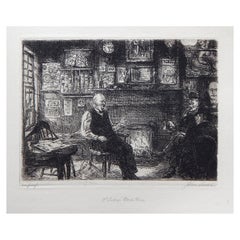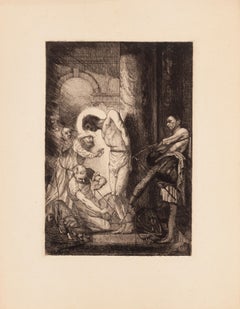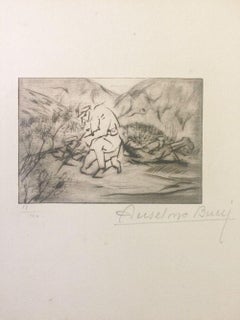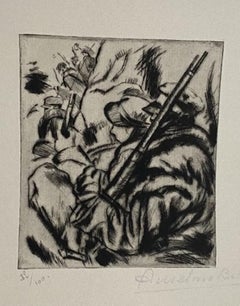1910s Figurative Prints
to
64
390
65
82
13
18
Overall Width
to
Overall Height
to
191
63
24
12
7
1
1
1
1
101
34
22
18
17
3,533
7,600
25,053
6,445
295
599
1,410
1,230
1,260
2,238
3,198
5,156
2,817
1,291
3,031
371
194
2
521
258
239
205
162
123
120
66
64
62
46
42
37
26
22
21
18
17
14
14
198
177
129
114
74
39
192
259
240
Period: 1910s
John Sloan Etching, 1916, "McSorley's Back Room"
By John Sloan
Located in Phoenix, AZ
John Sloan (1871-1951) etching created 1916.
Edition: 100
Titled: “McSorley’s Back Room”
Plate size: 5 1/4" H x 7 " W
Sheet size: 7 1/2" H x 10 3/8" W
In excellent condition, unframe...
Category
1910s Figurative Prints
Materials
Paper
Christ à la Colonne - Etching by E. Guillez - 1910
Located in Roma, IT
Christ à la Colonne in an original etching realized in 1910 by Edouard Guillez.
Category
1910s Figurative Prints
Materials
Etching
On Tire - Original Etching by Anselmo Bucci - 1917
Located in Roma, IT
Image dimensions: 8.5 x 12 cm.
Hand signed. Edition of 100 prints on Hollande paper. From the collection: Croquis du Front Italien, published in Paris by D'Alignan editions. Anselmo...
Category
Futurist 1910s Figurative Prints
Materials
Drypoint, Etching
Military - Original Etching by Anselmo Bucci - 1917
Located in Roma, IT
"Military" 1917 is a beautiful print in etching technique, realized by Anselmo Bucci (1887-1955).
Hand signed. Numbered 89/100 of prints on the lower left. On the lower left corner,...
Category
Modern 1910s Figurative Prints
Materials
Etching
Group of Men - Original Lithograph by Anselmo Bucci - 1918
Located in Roma, IT
Group of Men is an original lithograph on cream-colored paper, signed by the Italian artist, painter, and printmaker Anselmo Bucci, Hand-signed and dated on the lower margin of artwo...
Category
Futurist 1910s Figurative Prints
Materials
Lithograph
Strong Girl
By Walt Kuhn
Located in New York, NY
Walt Kuhn (1877-1949), Strong Girl, drypoint, 1916 [signed in pencil by Kenneth Hays Miller and inscribed “Zinc sheet E printed by Howard Moore Park 1928”). In very good condition, printed on a cream wove paper, 7 1/2 x 5 1/4, the sheet 11 1/8 x 8 1/2 inches.
Provenance: ex Collection: The Metropolitan Museum of New York, with their stamp verso.
ex Coll: Jonathan Greenberg, New York City
A very good impression of this rare early Kuhn print.
This is listed as number 48 in the Kennedy Galleries Walt Kuhn Checklist, made for an exhibit of his prints in 1967; it is cited as a print where no more than 6 impressions are known to exist.
Kuhn was of course intimately familiar with circuses and carnivals...
Category
American Modern 1910s Figurative Prints
Materials
Drypoint
Fusilier - Etching by Anselmo Bucci - 1917
Located in Roma, IT
Image dimensions: 6 x 5 cm.
Hand signed. Edition of 100 prints on Hollande paper. From the collection: “Croquis du Front Italien” , published in Paris by D'Alignan editions. Anselm...
Category
Futurist 1910s Figurative Prints
Materials
Drypoint, Etching
Caffè Greco - Original Print - 1918
Located in Roma, IT
Greek Café is an original lithograph by the Italian artist, painter, and printmaker Anselmo Bucci.
Signed on the plate on the lower right and titled.
In very good conditions.
The ...
Category
Futurist 1910s Figurative Prints
Materials
Lithograph
Le Coup de Canon - Original Etching by Anselmo Bucci - 1917
Located in Roma, IT
Image dimensions: 13 x 8.5 cm.
Hand signed. Edition of 100 prints on Hollande paper. From the collection: “Croquis du Front Italien” , published in Paris by D'Alignan editions. Anse...
Category
Futurist 1910s Figurative Prints
Materials
Drypoint, Etching
Le Long De La Route - Original Etching by Anselmo Bucci - 1915
Located in Roma, IT
Image dimensions: 9.5 x 7 cm.
Hand signed. Edition of 100 prints on Hollande paper. From the collection: “Croquis du Front Italien”, published in Paris by D'Alignan editions. Anselm...
Category
Futurist 1910s Figurative Prints
Materials
Drypoint, Etching
Adam und Eva
By Max Beckmann
Located in Berlin, DE
Signed in pencil lower right Beckmann. From the edition of 50 impressions on different papers. Aside from this edition, Hofmaier records 4 proof impressions (II and III A). Strong im...
Category
Expressionist 1910s Figurative Prints
Materials
Drypoint
Spleen - Original Etching by Anselmo Bucci - 1917
Located in Roma, IT
Image dimensions: 9 x 21 cm.
Hand signed. Edition of 100 prints on Hollande paper. From the collection: “Croquis du Front Italien” , published in Paris by D'Alignan editions. Anse...
Category
Futurist 1910s Figurative Prints
Materials
Drypoint, Etching
Halte - Etching by Anselmo Bucci - 1917
Located in Roma, IT
Image dimensions: 15 x 9 cm.
Hand signed. Edition of 100 prints on Hollande paper. From the collection: “Croquis du Front Italien” , published in Paris by D'Alignan editions. Anselm...
Category
Futurist 1910s Figurative Prints
Materials
Drypoint, Etching
Portrait of an Elderly Woman Praying at a Table Etching
Located in Houston, TX
Portrait of a woman praying at a table with food. In the corner a cat reaching up to see over the table. The etching is signed by the artist in the botto...
Category
Naturalistic 1910s Figurative Prints
Materials
Etching
L‘ennemi est en Vue - Original Etching by Anselmo Bucci - 1915
Located in Roma, IT
Image dimensions: 11 x 13.5 cm.
Hand signed. Edition of 100 prints on Hollande paper. Here are represented some of the most important exponents of Futurism such as Marinetti and Boc...
Category
Futurist 1910s Figurative Prints
Materials
Drypoint, Etching
Le Froid - Original Etching by Anselmo Bucci - 1917
Located in Roma, IT
Image dimensions: 11.5 x 14 cm.
Hand signed. Edition of 100 prints on Hollande paper. From the collection: “Croquis du Front Italien”, published in Paris by D'Alignan editions. Ans...
Category
Futurist 1910s Figurative Prints
Materials
Drypoint, Etching
Les Mitrailleuses - Etching by Anselmo Bucci - 1917
Located in Roma, IT
Image dimensions: 18 x 14.5 cm.
Hand signed. Edition of 100 prints on Hollande paper. From the collection: “Croquis du Front Italien” , published in Paris by D'Alignan editions. Ans...
Category
Futurist 1910s Figurative Prints
Materials
Drypoint, Etching
Selbstmörder - Original Etching and Drypoint by Magnus Zeller - 1919
By Magnus Zeller
Located in Roma, IT
Selbstmörder is an original drypoint, realized by Magnus Zeller in 1919, signed and inscribed,
Included a frame.
In very good conditions.
The artwork is representing a desperate m...
Category
Expressionist 1910s Figurative Prints
Materials
Drypoint, Etching
Junge Frau mit Blumenvase - Original Etching by Karl Koepping - 1910
Located in Roma, IT
Junge Frau mit Blumenvase (Young Woman with a flower vase) is a wonderful black and white etching with aquatint and drypoint interventions on cream-colored paper, realized in 1910 b...
Category
Symbolist 1910s Figurative Prints
Materials
Etching, Aquatint
The Broad Curtain
Located in New York, NY
A superb, richly-inked impression of this very scarce lithotint on Japan paper. Edition of approximately 55. Signed with the artist's cypher in pencil, lower right.
Category
American Impressionist 1910s Figurative Prints
Materials
Lithograph
Les Drapeaux ( The Flags )
Located in Paonia, CO
Henri DeGroux (1866-1930) was a Belgian Symbolist painter, sculptor and lithographer. He was known for his allegorical, religious and historical subject matter. He became an inspired...
Category
Symbolist 1910s Figurative Prints
Materials
Lithograph
I Buffoni - Vintage Adv Lithograph by L. Metlicovitz - 1914
Located in Roma, IT
Image dimensions: 26.2x9.1 cm.
I Buffoni is a beautiful colored lithographed original manifesto on cardboard, realized by the Italian artist and one of the fathers of the modern Italian poster art, Leopoldo Metlicovitz (Trieste, 1868 - Ponte Lambro, 1944). Printed by Officine Ricordi, Milan in 1914, this advertising poster for "I Buffoni" is inspired by the Art Nouveau graphic style.
Indeed Metlicovitz, through the Ricordi, realized much advertising posters and manifestoes for many emerging companies such as Pirelli, Ettore Moretti, Magazzini Mele in Naples, relied with his talented pencil. The Liberty atmosphere is palpable from the sensuality of the female body appearing flat and emptied and turning into a mere twisted black contouring graphic line. The colors are enameled, the languid glances, the fixed smiles, veined by an almost imperceptible underground decadence that is a prelude to the First World War.
This is a wonderful vintage advertising poster, with the inscriptions printed on lower margin, under the image: "L. Metlicovitz / Off. G. Ricordi and C. Milano / 70 x 200. In excellent conditions, except for some minor stains along the margins.
This modern artwork shows the vintage Art Nouveau taste and the Metlicovitz's draftsmanship and his full mastery of the artistic medium, has the dignity of an object of art to collect and could be a colorful and fashionable piece for your sophisticated home furniture.
Leopoldo Metlicovitz (Trieste, 1868 - Ponte Lambro, 1944)
The Italian painter, illustrator, theatrical and advertising scenographer is considered one of the precursors of Futurism and, together with Leonetto Cappiello, Adolf Hohenstein, Giovanni Maria Mataloni and Marcello Dudovich, one of the fathers of modern Italian poster art.
He began his artistic career at the age of fourteen working as an apprentice in a typography in Udine, where he learned the technique of lithography. Here he is noticed by Giulio Ricordi, owner of the namesake Officine Grafiche, who invites him to Milan to work as a lithographer. In 1892, after collaborating with Tensi, a photographic product company, he returned to Ricordi as technical director. At the same time, he entered the theatrical environment and began his career as a set designer and costume designer at La Scala. The Mele di Napoli tailoring company entrusted him with the task of advertising his clothes and in 1906, on the occasion of the great Universal Exposition in Milan, he won the competition for the fair poster, establishing himself also as a poster artist and then collaborating with several magazines as an illustrator. For Ricordi he takes care of the illustrations of calendars, opera librettos, postcards. Other famous images created by him are those for the poster of the film Cabiria, a blockbuster of the silent film scripted by Gabriele D'Annunzio, and the trademark that is still used today by the Brothers Branca Distilleries, producers of Fernet Branca...
Category
1910s Figurative Prints
Materials
Lithograph
Rotten Row (Hyde Park) by Ludovic-Rodo Pissarro - Wood engraving
Located in London, GB
SOLD UNFRAMED
Rotten Row (Hyde Park) by Ludovic-Rodo Pissarro (1878-1952)
Wood engraving
13.5 x 12.5 cm (5 ¼ x 4 ⅞ inches)
Initialed and titled in the plate
Executed circa 1917
Artist biography
Ludovic-Rodolphe Pissarro, born in Paris in 1878, was Camille Pissarro’s fourth son. Encouraged by his father...
Category
1910s Figurative Prints
Materials
Woodcut, Engraving
Portrait Etching of English Victorian Poet Elizabeth Barrett Browning
Located in Houston, TX
Etching of a woman dressed in turn of the century attire looking out at the viewer. The work is signed in pencil by the artist. The etching is not framed.
Artist Biography: William...
Category
Naturalistic 1910s Figurative Prints
Materials
Etching
THE FARMER AND CHILDREN (A NEW ENGLAND FAMILY, or THE FATHER).
Located in Portland, ME
Zorach, Marguerite. THE FARMER AND CHILDREN (also titled A NEW ENGLAND FAMILY, or THE FATHER). Linoleum cut, circa 1917. Titled, Signed, and dated 1920 in pencil in the margin and si...
Category
1910s Figurative Prints
Materials
Linocut
Chen Quian. Advertisement for B.S Insurance Co
Located in New York, NY
Artist: Chen Quian.
[Advertisement for B.S Insurance Co.] 1912
Color lithograph, Rare. Very early Chinese advertising poster at the end of the
Qu...
Category
Qing 1910s Figurative Prints
Materials
Lithograph
"Harvest (Sugar Beets), " Aquatint Etching by Manuel Robbe, circa 1910
By Manuel Robbe
Located in Long Island City, NY
This etching with aquatint was created by French printmaker Manuel Robbe. Robbe’s innovative techniques, along with his sense of color harmony and his choice of subjects: stylish wom...
Category
Impressionist 1910s Figurative Prints
Materials
Etching, Aquatint
Timothy Cole after Vermeer, "Woman with Water Jug, " Photolithograph, circa 1910
By Timothy Cole
Located in Long Island City, NY
Artist: Timothy Cole after Johannes Vermeer
Title: Woman with Water Jug
Year: 1912
Medium: Photolithograph, signed in pencil, marked Vermeer, Metr...
Category
Old Masters 1910s Figurative Prints
Materials
Photogravure
Fleet Street by Ludovic-Rodo Pissarro - Woodcut
Located in London, GB
Fleet Street by Ludovic-Rodo Pissarro (1878-1952)
Wood engraving
11.2 x 11.2 cm (4 ³/₈ x 4 ³/₈ inches)
Initialled, titled and dated on the plate
Signed lo...
Category
1910s Figurative Prints
Materials
Woodcut
By the Sea (aka Idyll)
Located in New York, NY
Arthur B. Davies (1862-1928), By the Sea (aka Idyll), soft ground etching and aquatint, 1919, signed in pencil lower right. Reference: Czestochowski 72, fourth state (of 5; see disc...
Category
American Impressionist 1910s Figurative Prints
Materials
Etching, Aquatint
Baptism (or, Group of Ten Men – One Seated)
Located in New York, NY
Arthur B. Davies (1862-1928), Baptism (or, Group of Ten Men – One Seated), drypoint on zinc, 1917, signed in pencil , printed in black on very thin laid paper. In very good condition...
Category
Cubist 1910s Figurative Prints
Materials
Drypoint
Portrait - Etching by Francis Brooks Chadwick - 1915
Located in Roma, IT
Outstanding etching realized by Chadwick in 1915,
Monogrammed in pencil lower right.
Very good condition.
Category
Modern 1910s Figurative Prints
Materials
Etching
Cycles Motos Alcyon.
Located in London, GB
GAMY and MONTAUT, Ernest.
Cycles Motos Alcyon.
[Paris: Mabileau & Co., c. 1914].
Hand-coloured pochoir print. Framed and glazed, overall size: 93.6cm x 49.2cm.
The Gamy-Montaut ...
Category
Art Deco 1910s Figurative Prints
Materials
Screen, Stencil
Junger Fürst und Tänzerinnen
By Emil Nolde
Located in New York, NY
A superb impression of this extremely scarce etching and aquatint. First state (of 2), before the darkened background. Edition of approximately only 11. Signed in pencil.
This etch...
Category
Expressionist 1910s Figurative Prints
Materials
Etching, Aquatint
BARBER SHOP
By John Sloan
Located in Portland, ME
Sloan, John. BARBER SHOP. Etching and aquatint, 1915, (Morse 173), 3rd (final) state, Only 35 were printed, by Sloan. Signed in pancil, lower right. 10 x 12 inches (256 x 308 mm (pl...
Category
1910s Figurative Prints
Materials
Etching, Aquatint
Satyre et Nymphe se Baignant dans un éta - Etching by Ker Xavier Roussel - 1900s
Located in Roma, IT
Beautiful proof of state on vélin, with notes by the author “1er essai” in pencil.
Full margins.
Ref. Cat. Salomon 98.
Prov. Collection Henri Petiet, Paris.
Category
Modern 1910s Figurative Prints
Materials
Etching
Picasso, Composition (Hodorisch B2), Le manuscrit trouvé dans un chapeau (after)
Located in Southampton, NY
Lithograph on vélin des papeteries Lafúma paper. Unsigned and unnumbered, as issued. Good condition. Notes: From the album, Le manuscrit trouvé dans un chapeau, orné de dessins a la ...
Category
Modern 1910s Figurative Prints
Materials
Lithograph
$716 Sale Price
20% Off
Une Marmite
Located in New York, NY
Jean-Emile Laboureur (1877-1943), Une Marmite, engraving, 1916, signed in pencil lower left; titled, dated and inscribed “epreuve de 1er etat” bottom margin edge [with the initial an...
Category
Art Deco 1910s Figurative Prints
Materials
Engraving
Rozsa/Szucs
Located in New York, NY
Rozsa/Szucs. Ca 1915. Budapest. Color lithograph. Hungarian Art Nouveau posters are rare.
Bardócz was a graphic artist and painter, active between the 1910’s and the 1930’s.
His p...
Category
Art Nouveau 1910s Figurative Prints
Materials
Lithograph
Les Vins de Bourgogne.
By Guy Arnoux
Located in New York, NY
Les Vins de Bourgogne. printed by Devambez, Paris, signed in the
plate. 1916. Color lithograph. On Linen
Guy Arnoux is an artist , illustrator and graphic designer French.
He ...
Category
Art Deco 1910s Figurative Prints
Materials
Lithograph
Barbershop
By John Sloan
Located in New York, NY
John Sloan (1871-1954), Barbershop, 1915, etching and aquatint, signed in pencil lower right, inscribed in pencil “For John Quinn, Esq. – John Sloan” lower left margin, (also signed ...
Category
Ashcan School 1910s Figurative Prints
Materials
Etching, Aquatint
$12,000
La Fille aux Oies
Located in New York, NY
Jean-Emile Laboureur (1877-1943), La Fille aux Oies, engraving, 1916, signed in pencil lower left, numbered (4/40) lower right and inscribed “imp,” also titled lower left margin edge...
Category
Cubist 1910s Figurative Prints
Materials
Engraving
20th century etching figurative urban scene sketch black and white signed
Located in Milwaukee, WI
"Les Matelassiers (The Mattress Makers)" is an original etching by Auguste Brouet. It depicts people creating a mattress outside. The artist signed the...
Category
Modern 1910s Figurative Prints
Materials
Etching
Le Souper des Dockers
Located in New York, NY
Jean-Emile Laboureur (1877-1943), Le Souper des Dockers, engraving, 1919-1920, signed in pencil lower left, titled lower left, and numbered (27/35) lower right. Reference: Laboureur ...
Category
Cubist 1910s Figurative Prints
Materials
Engraving
MARSH GUNNER
By Frank Benson
Located in Portland, ME
Benson, Frank. MARSH GUNNER. Paff 149. Etching, 1918. Edition of 150. Signed in pencil, lower left, and numbered "93" in pencil, lower right. 10 7/8 x 8 7/8 inches (plate), 15 3/4 x ...
Category
1910s Figurative Prints
Materials
Etching
"World War I Poster - Uncle Sam, " Lithograph printed by Meisenheimer Milwaukee
Located in Milwaukee, WI
This World War I poster, featuring Uncle Sam, was printed by Meisenheimer-Milwaukee and was sponsored by the Woman's Liberty Loan Committee. The ar...
Category
Other Art Style 1910s Figurative Prints
Materials
Lithograph
Tightrope Dancer
Located in New York, NY
ROYDS, Mabel Allington. Tightrope Dancer, ca 1911. Color woodcut. MB 1. From a small edition. Signed and titled in pencil.
After working with Walter Sickert in Paris at the turn ...
Category
Realist 1910s Figurative Prints
Materials
Woodcut
Deposition - Woodcut Print by René Leclercq - 1914
Located in Roma, IT
Deposition is an artwork realized by René Leclercq (1880 - 1949, Belgium) in 1914.
Good condition.
Woodcut print.
Category
Modern 1910s Figurative Prints
Materials
Woodcut
My Grandfather - Woodcut by Jan Claessens - 1914
Located in Roma, IT
My Grandfather is an artwork realized by Jan Claessens (Belgian, 1879 - 1963) in 1915.
Woodcut print.
Good condition.
Category
Modern 1910s Figurative Prints
Materials
Woodcut
Anzacs
Located in New York, NY
Jean-Emile Laboureur, Anzacs, woodcut, 1918-22, signed and numbered (7/45), the second state (of 2). Reference: Sylvain Laboureur 713. In good condition, with remains of old hinges ...
Category
Cubist 1910s Figurative Prints
Materials
Woodcut
The Dining Room - Etching by Georges Jeanniot - 1915
Located in Roma, IT
The Dining Room is an Etching realized by Georges Jeanniot in the late 19th Century.
Signed in the lower.
Good condition.
Category
Modern 1910s Figurative Prints
Materials
Etching
Dawn (or, Kneeling Figure)
Located in New York, NY
Arthur B. Davies (1862-1928), Dawn (or, Kneeling Figure), 1918, soft ground etching and aquatint, signed in pencil lower right. Reference: Czestochowski 59, second state (of 3). In v...
Category
1910s Figurative Prints
Materials
Etching, Aquatint
Fruhling
By Josef Siccard-Redl
Located in New York, NY
Siccard-Redl, Josef. Fruhling, Ca 1910. Color wood engraving, Signed and titled in pencil by the artist.
Little is known of this artist other than he worked in Vienna during the
...
Category
Vienna Secession 1910s Figurative Prints
Materials
Engraving
Anshutz on Anatomy
By John Sloan
Located in New York, NY
John Sloan (1871-1951), Anshutz on Anatomy, etching, 1912, signed titled and inscribed “100 proofs” by the artist, and also signed “Ernest Roth imp” by the printer. Reference: Morse 155, eighth state (of 8), from the edition of 80. In very good condition, the full sheet, printed in dark brown ink on a brown/tan wove paper, 7 1/2 x 9, the sheet 11 1/8 x 12 3/4 inches.
A fine impression.
Sloan wrote of this print: “Tom Anshutz, our old teacher at the Pennsylvania Academy, gave anatomical demonstrations of great value to art students. Modelling the muscles in clay, he would then fix them in place on the skeleton. Those present in this etched record of a talk in Henri’s New York class include: Robert and Linda Henri, George Bellows, Walter Pach...
Category
American Realist 1910s Figurative Prints
Materials
Etching
Morning on the East Side
By Jerome Myers
Located in New York, NY
Jerome Myers (1867-1940), Morning on the East Side, c. 1910, colored etching, signed in pencil lower right and annotated “imp.”; numbered and titled (twice) lower left. In very good ...
Category
1910s Figurative Prints
Materials
Color, Etching
"Le Petit Cirque Prinder, " Original Etching signd by Auguste Brouet
Located in Milwaukee, WI
"Le Petit Cirque Prinder" is an original etching by Auguste Brouet. This piece depicts a variety of circus performers surrounded by small children. The artist signed the piece in the...
Category
Academic 1910s Figurative Prints
Materials
Pencil, Etching
Ex Libris - J. Sigale's - Woodcut by José (Josepe) Viola - 1911
Located in Roma, IT
Ex Libris - J. Sigale's is a Modern Artwork realized in 1911 s. by José (Josepe) Viola.
Ex Libris. B/W woodcut on paper.
The work is glued on ivory cardboard. Signed on plate an...
Category
Modern 1910s Figurative Prints
Materials
Woodcut
Le Rêve - Etching and Drypoint by Anselmo Bucci - 1917
Located in Roma, IT
Le Rêve-from "Le Croquis du Front Italien" is an Artwork, Drypoint, realized by the Italian Artist Anselmo Bucci, in 1917.
Hand signed on the right margin . Edition n. 18/100 specimens on Hollande paper. From the collection: “Croquis du Front Italien” , published in Paris by D'Alignan editions.
Good conditions, except for a light yellowing of the paper and some foxing.
Anselmo Bucci (1887-1955) was an Italian painter and printmaker.
He took part in the Salon des Indépendants from 1910 on. He enlisted in the Volunteer Cyclist Battalion in 1915 and he became one of the most famous Italian war...
Category
Modern 1910s Figurative Prints
Materials
Etching, Drypoint
"Matinee a l'Odeon, " Original Etching signed by Maurice Asselin
Located in Milwaukee, WI
"Matinee a l'Odeon" is an original etching by Maurice Asselin. The artist signed and titled the print below the image. This piece is edition 13/30 and depicts three figures watching ...
Category
Post-Impressionist 1910s Figurative Prints
Materials
Etching
Against Green
Located in New York, NY
Arthur B. Davies (1862-1928), Against Green (also Three Figure Composition, Figures Against Green), soft ground etching and aquatint, 1918, signed in pencil lower right; also titled ...
Category
American Impressionist 1910s Figurative Prints
Materials
Etching, Aquatint
Recently Viewed
View AllMore Ways To Browse
Kim Tschang Yeul
Tom Blackwell On Sale
Tom Everhart Lithograph
Torii Kotondo
Victor Richardson
Vintage Boulangerie Signs
Vintage Les Nereides
Vintage Meat Scales
Vintage Multiplier Reel
Warhol Northwest Mask
Whistler Fumette
Yoko Ono Lithograph Harold Town
Zeno Giglietti
Ak47 Lotus
Alex Katz Bicycle
Alex Katz Christy
Alex Katz Twilight
Alex Katz Wedding Dress




